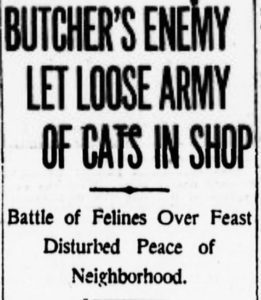
One of several headlines that appeared on November 5, 1914, the day after a clowder of cats went wild in the butcher shop at 70 James Street.
Prelude to the 1914 Cat Attack
In the early morning hours of November 4, 1911, a bomb went off in front of a butcher shop and coffee saloon on the northwest corner of James Street and Oak Street in New York City’s Lower East Side. The explosion could be heard two blocks away at the Oak Street police station and as far away as police headquarters at 240 Centre Street.
According to news reports, the criminals had used a bomb constructed of black powder and wrapped in rolls of paper held together with twine. The destruction was intended for the butcher shop at 70 James Street, but its effects were felt by the whole neighborhood.
When the bomb went off, several customers in Michael Talliento’s coffee saloon at 70 1/2 James Street were thrown from their chairs. The force also blew out all the windows of the butcher shop — which was on the ground floor of the six-story tenement building — and damaged the entire front of the building. Members of the 40 families who lived in the building clogged the stairwell and fire escapes as they tried to escape the building with their belongings and household treasures.
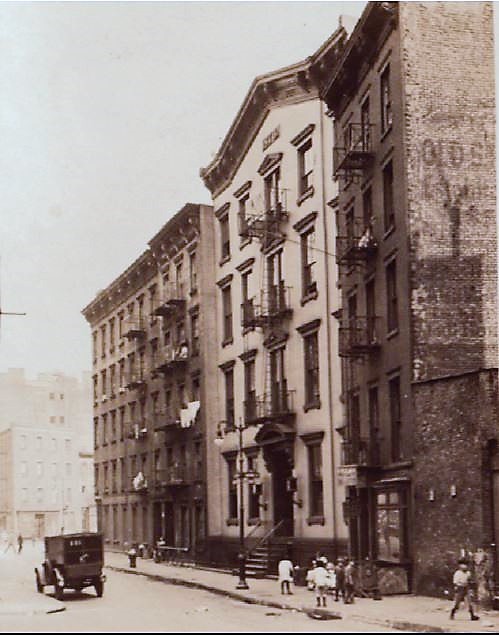
The sound of the explosion was heard at the Fourth Precinct police station at 9 Oak Street, constructed in 1860 and pictured here (middle, white) in 1927. The police station was two blocks from the butcher shop. New York Public Library Collections
Windows fell for blocks along James, Oak, Oliver, and Madison Streets. A dozen large windows were cracked at Public School 114 across the street.
According to news reports, the butcher, Ignatz Sethmaier, had just moved from his former butcher shop at Avenue A and 14th Street a month before the blast. He told police that he had been receiving letters every day demanding he move out. He said he had even gone to the police recently when he found the lock to the front door had been filed away and a two-gallon can filled with kerosene had been placed at the front door.
Sethmaier reportedly had a rival across the street at 69 James Street, which was also a butcher shop run by a man from Sicily. The detectives believed that the Italians had been watching the success of the Jewish butcher with jealousy. Sethmaier had been underselling other butchers in the neighborhood by marking cuts of meat in his window as low as 8 or 10 cents, while in the other butcher shops the prices were 14 and 16 cents. Sethmaier employed three clerks, and his business had been flourishing.
Cats Go on Attack in the Butcher Shop

The gloves came off when about 25 cats were tossed into the butcher shop at 70 James Street on the evening of January 23, 1914. (How on earth did they ever get the gloves on these cats in the first place?)
On the evening of January 23, 1914. Policeman James Kenny of the Oak Street police station was making the rounds when he heard a horrific sound coming from what was by this time Mr. J. Wynberger’s butcher shop at 70 James Street. Recalling the horrific bomb explosion of 1911, Kenny assumed the worst. He blew his whistle and thumped his night stick to call for assistance. Seven other policemen came running to the scene.
With pistols drawn, they tried to force open the door, but to no avail. Moving to Plan B, they found a young man named Tommy Laura who was small enough to fit through the fanlight or transom window — the same opening above the door through which the cats had made their way.
Tommy fell to the floor, turned on the lights, and found a pair of pliers to open the jammed door. When the police officers went inside, they were greeted not by the mob, but by a mob scene of about 25 cats attacking each other and doing a butcher job on every scrap of meat in the market. As the New York Sun reported:
“The cats were of all sizes and colors. They had been hungry, but were no longer. They had eaten every scrap of meat in the market — chicken and beef and everything else, and were fighting over the bones.”

A butcher shop like this one, pictured in 1899, must have been the fantasy of all the starving street cats. Being tossed into a shop filled with a smorgasbord of raw meat was no doubt a dream come true for the cats on James Street.
As the policemen attempted to chase the cats out the door using nightsticks and brooms and shouting “Scat!”, several civilians joined in to help. One poor lad was clawed so badly that he had to be treated at the hospital. Although the felines fought hard (they were not about to give up this opportunity so easily), the officers were eventually able to evict all 25 cats, including two tame shop cats that had been living in the butcher shop and had been trained by Mr. Wynberger to not eat the meat.
As the cats ran off with pieces of meat in their mouths, the police surmised that an enemy of Mr. Wynberger had collected the cats, starved them, and then pushed them through the transom window. As was reported in The Evening World:
“The first cat pushed through the transom was pounced on by the faithful felines on watch. They grabbed him and sought to shove him in the sausage grinder. But then it began to rain cats. The guardians of the garbage cans made short shrift of the tame tabbies of the butcher shop.”
Mr. Wynberger told the police that he did not know who had pulled this catastrophic prank. “Yes, it might have been a rival,” he said. “I don’t know.” There were no arrests.
Goats on the Loose
In 1930, 70 James Street was still a butcher shop, but by this time it was owned by John Catena. In April 1930, John made the headlines when two goats that he had tethered in a back room of the shop broke free and created havoc once again for the men of the Oak Street police station.
According to the New York Evening Post, when the goats got loose, they romped all about the butcher shop, trampling strips of bacon, devouring a sign that said “Chops and Roasts” in the front window, and leaving tufts of wool on the meat hooks.
The troublemaker goats also overturned a telephone in the room. When the operator plugged into the line, she heard “agonized cries which sounded like foul play.” She called the police, who found the goats bleating into the mouthpiece of the phone when they arrived.
The police called John Catena, and he was able to round up the goats and lead them to his apartment upstairs. I do not wish to know the final fate for the mischievous goats.

This view from Oak Street and Catherine Street, looking southeast toward the Brooklyn Bridge, was taken in 1944. This entire neighborhood up to the bridge and East River waterfront was cleared away to build the Governor Alfred E. Smith Houses in the early 1950s.
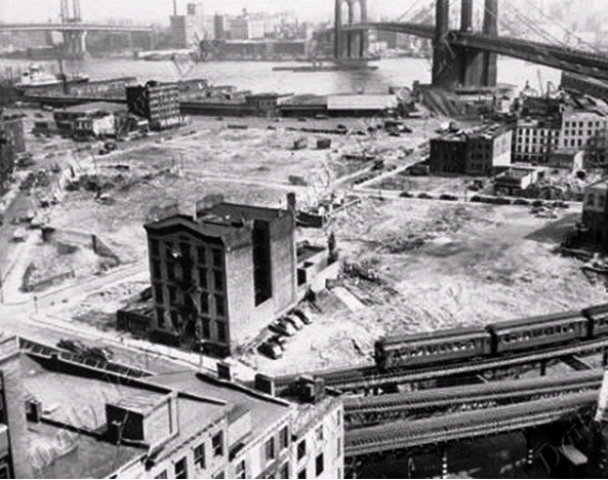
The old Oak Street station house of the Fourth Police Precinct was among the last structures to be removed when the Lower East Side neighborhood where cats once raided a butcher shop was demolished to make way for the Albert E. Smith housing project. This photo was taken around 1950.
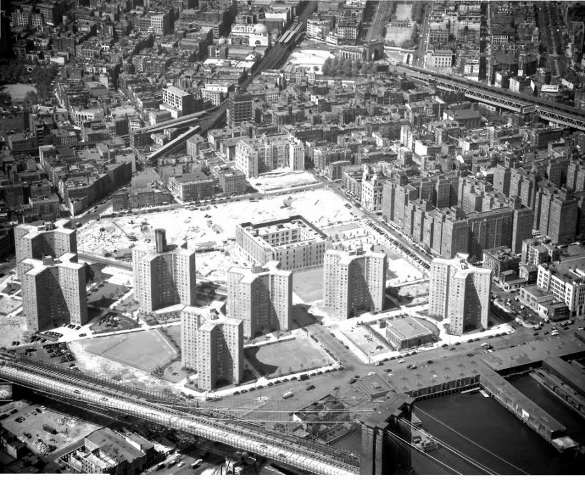
Construction of the Alfred E. Smith Houses began in 1950 and was completed in 1953. The butcher shop at 70 James Street was right about in the center of this photo, where the large square building is going up (this building would later become a homeless shelter).
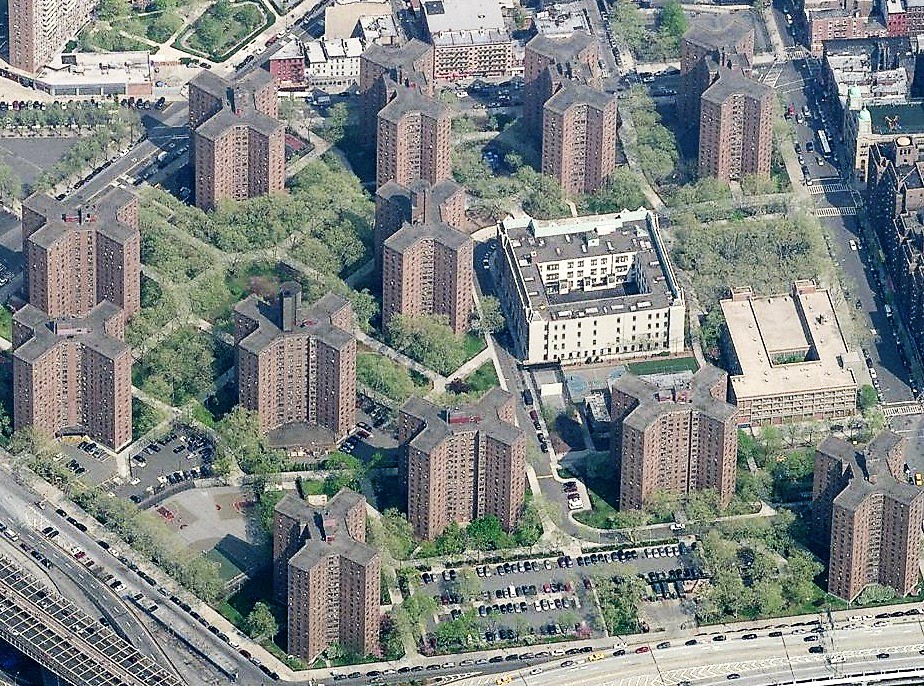
The Alfred E. Smith Houses as they look today.



And each cat ate only two bites – if they were anything like my cats. That’s why they needed an army.